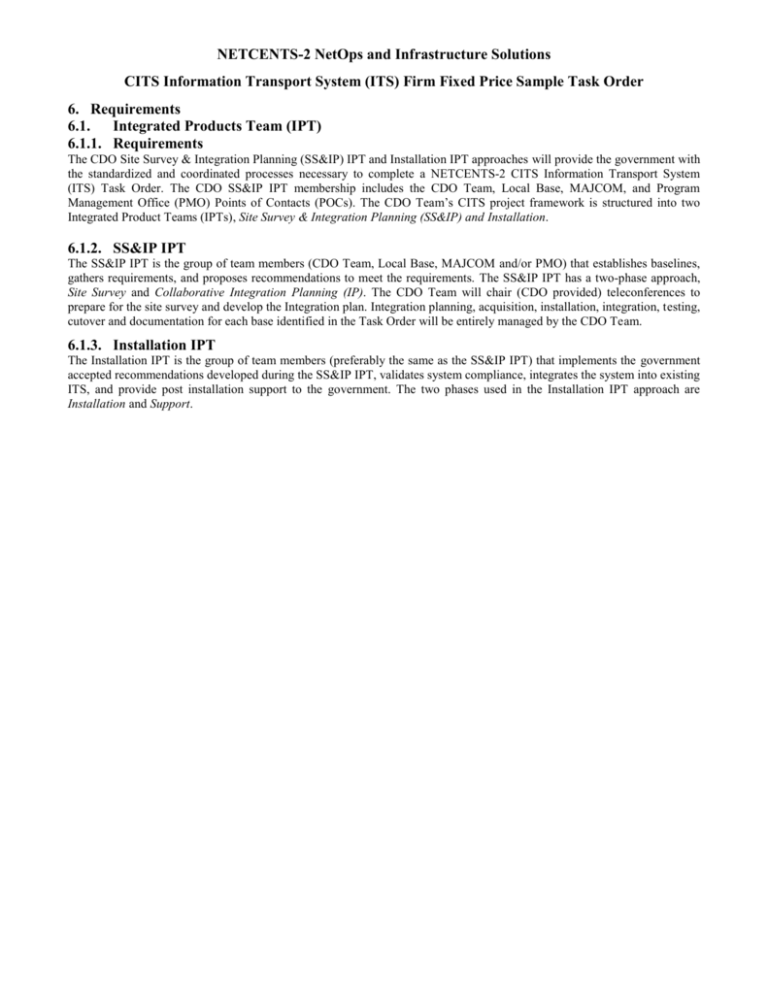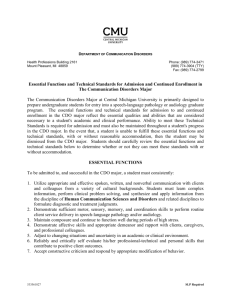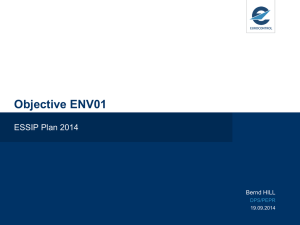NETCENTS
advertisement

NETCENTS-2 NetOps and Infrastructure Solutions CITS Information Transport System (ITS) Firm Fixed Price Sample Task Order 6. Requirements 6.1. Integrated Products Team (IPT) 6.1.1. Requirements The CDO Site Survey & Integration Planning (SS&IP) IPT and Installation IPT approaches will provide the government with the standardized and coordinated processes necessary to complete a NETCENTS-2 CITS Information Transport System (ITS) Task Order. The CDO SS&IP IPT membership includes the CDO Team, Local Base, MAJCOM, and Program Management Office (PMO) Points of Contacts (POCs). The CDO Team’s CITS project framework is structured into two Integrated Product Teams (IPTs), Site Survey & Integration Planning (SS&IP) and Installation. 6.1.2. SS&IP IPT The SS&IP IPT is the group of team members (CDO Team, Local Base, MAJCOM and/or PMO) that establishes baselines, gathers requirements, and proposes recommendations to meet the requirements. The SS&IP IPT has a two-phase approach, Site Survey and Collaborative Integration Planning (IP). The CDO Team will chair (CDO provided) teleconferences to prepare for the site survey and develop the Integration plan. Integration planning, acquisition, installation, integration, testing, cutover and documentation for each base identified in the Task Order will be entirely managed by the CDO Team. 6.1.3. Installation IPT The Installation IPT is the group of team members (preferably the same as the SS&IP IPT) that implements the government accepted recommendations developed during the SS&IP IPT, validates system compliance, integrates the system into existing ITS, and provide post installation support to the government. The two phases used in the Installation IPT approach are Installation and Support. NETCENTS-2 NetOps and Infrastructure Solutions CITS Information Transport System (ITS) Firm Fixed Price Sample Task Order 6.2. Site Survey & Integration Planning IPT Figure 1: Site Survey Processes Site Survey Phase The SS&IP IPT’s Site Survey Phase is broken into five tasks, Award, Coordination, Preparation, Pre-Site Survey and Site Survey. Award Task Given the Task Order has been awarded to the CDO Team from the NETCENTS (or sponsoring) PMO, CDO extracts a list of responsibilities from the Statement of Work (SOW). CDO will provide an Outline of Responsibilities to the PMO who intern inputs and acknowledges those responsibilities in a Letter of Intent. CDO outlining responsibilities and the PMO verifying them allows the project to proceed in a mutually accepted direction. Coordination Task The Letter of Intent will be forwarded to the Local Base (in this instance, Yakota AFB) to understand the scope of the project and outline the responsibilities of the CDO Team, the PMO, the MAJCOM, and the Local Base. The Local Base will allocate the resources (people, places, things) outlined in the Letter of Intent required for project coordination and completion. The CDO Team will provide the Local Base, MAJCOM and PMO a packet of information (paper or electronic) containing the Project Overview, all Guidance (e.g. Letter of Intent, SOW, etc.), Pre-Site Survey Checklist, Site Survey Checklist(s), and a list of CDO Team POCs. NETCENTS-2 NetOps and Infrastructure Solutions CITS Information Transport System (ITS) Firm Fixed Price Sample Task Order 6.2.1. Topology Development Preparation Task The CDO Team will host a Pre-Site Survey teleconference (CDO Team provided worldwide “Meet Me” phone number and access code) with CDO representatives, CDO Team members, and Local Base, MAJCOM and PMO representatives. It is preferred to have all required base personnel (Civil Engineering, Communication Squadron, etc) attend this teleconference and future project planning conferences. The CDO Team will maintain the Agendas and generate Meeting Minutes for all teleconferences and conferences. The Pre-Site Survey teleconference will begin with CDO Team Introductions. The Local Base will provide a list POCs to the CDO Team. All teleconference participants will review the CITS Checklist (if applicable), and the CDO Team’s Site Survey Checklist(s). The checklist review allows all project team members to be familiar with the processes associated with the Site Survey and recommend any changes. The CDO Team will incorporate any comments/concerns them into the Site Survey Agenda & Schedule. Local Base, MAJCOM, and PMO representatives will provide to the CDO Team, current CITS ITS architecture drawings and maps, a preliminary list of buildings (with associated building drawings and base maps), funded & designed Military Construction Projects (MCPs), demolitions, and major building renovations relevant to the Task Order The CDO Team will contact the MAJCOM point of contact (POC) to verify the security clearance levels necessary for workers to have/attain prior to the Site Survey and Installation phases. The CDO Team will provide individuals with the appropriate levels of clearances needed to complete the Task Order. The products developed through the Pre-Site Survey Teleconference are… The Site Survey Agenda & Schedule will be sent electronically for review and acceptance by all representatives (Local Base, MAJCOM, and PMO). The CDO Team will compile a list of all Limiting Factors (LIMFACs) and any extenuating circumstances (e.g. Base Exercise, Building Renovations, etc) discussed during the teleconference. The Proposed Travel Itinerary will be generated based on the Task Order Period of Performance (POP), LIMFACs, and any extenuating circumstances. The documented travel request processes establishes who (government approving official) and how (fax, email, etc.) to submit Travel Request allowing the CDO Team to receive Travel Authorization. All Site Survey required resources requests (office space, communications, building/network drawings, etc.) and government Furnished Equipment (GFE) (if applicable) would be discussed and provided to the CDO Team prior to any travel. 6.2.2. Site Survey Pre-Site Survey Task All documentation for the project (including the teleconferences) will be stored electronically in CDO’s instance of Microsoft Visual Source Safe (VSS). VSS allows CDO to have positive control of all associated documents. A binder with all corresponding documentation will be compiled and turned over to the government upon completion of the Task Order. The CDO Team will submit Visit Requests and receive Travel Authorization through the PMO. All travel related documents will be stored in CDO’s VSS system. Adhering to the Site Survey Agenda and Schedule the CDO Team will travel to the Local Base and conduct a Site Survey, which will generate documentation for the Integration Planning Phase and Installation IPT. Upon arrival, the CDO Team will lead a Site Survey In-Brief meeting. The CDO Team will introduce itself, review the Site Survey Agenda and Schedule, outline the formulation processes for the Integration Plan and Installation Plan, and receive any initial feedback from customer. The CDO Team will discuss any vendor selection criteria and preferences that may be applied to any equipment, material or labor (e.g. environmental assessment, digging, etc.). Site Survey Task The CDO Team will verify all data provided in the Preparation and Pre-Site Survey phases. The CDO Team will test all cabling scheduled for reuse and survey any current and proposed cable pathways for the Outside Plant (OSP) and Inside Plant (ISP). The Site Survey team will validate the current Network topology for CITS compliance and equipment status (expired warranty, standards (e.g. IPv6), component failures, etc.). At the completion of the Site Survey, the SS&IP IPT will meet to NETCENTS-2 NetOps and Infrastructure Solutions CITS Information Transport System (ITS) Firm Fixed Price Sample Task Order develop a detailed Integration Plan (IP). The proposed OSP, ISP and network topologies, Box Level Collaboration, vendor selection criteria and action items for the Out-Brief meeting. 6.2.3. Outside Plant //Need write up on how OSP will be site surveyed// 6.2.4. Inside Plant //Need write up on how ISP will be site surveyed// 6.2.5. Network Conducting a Network site survey, the CDO Team will visit each location listed in the SOW and the preliminary list of buildings annotated during the Pre-Site Survey Teleconference to verify all government provided data. The CDO Team will locate all existing network equipment on the building list. The CDO Team will verify the existing equipment and locations match the network topology provided to the CDO Team during the Preparation Task. Card/Port level connections will also be recorded. Power and HVAC capabilities and shortfalls in each network closet/location will be recorded. If possible, the CDO Team will also get a current configuration file from each ITN, EBN and/or network switch at each location. This data is critical in developing the Box Level Collaboration and Integration Plan. 6.2.6. Box Level Collaboration The Box Level Collaboration is a design matrix used to determine if the current ITNs and EBNs meet standard criteria established by the CITS program and by requirements specifically stated within the contract. The CDO Team will create an initial draft of the Box Level Collaboration to be used in the re-use/replace & vendor selection processes. The Box Level Collaboration will be finalized in the Integration Planning phase. 6.2.7. Vendor Selection The government will submit the Base’s Vendor Selection Base & MAJCOM Requirements Checklist to the CDO Team. The Vendor Selection criteria will be used by the Collaborative IP team to choose appropriate equipment and vendors to fulfill the requirements of the project. NETCENTS-2 NetOps and Infrastructure Solutions CITS Information Transport System (ITS) Firm Fixed Price Sample Task Order 6.3. Engineering/Detailed Collaborative IP Requirements 6.3.1. General The Collaborative IP Phase kicks off following the completion of the Site Survey Phase. In the Collaborative IP phase, the CDO Team will continue to develop a detailed IP with the necessary government validation and support. The Collaborative IP phase’s four tasks are Integration Plan, Documentation, Hardware Integration Plan Review (HWIPR) and Final Documentation Acceptance. Figure 2: Collaborative IP Workflow Integration Plan Task The CDO Team will convene with key Local Base and MAJCOM personnel to generate an initial Integration Plan (IP). The Integration Plan should be considered a living document as requirements might change due to product availability, lead times, base exercises, etc. The Integration Plan will be done in two parts, an initial IP (developed during the Site Survey) and the Collaborative IP. The initial IP has four major components, redlined DS & Network topologies, the Box Level Collaboration, Vendor Selection Document (VSD) and Action Items. Redlined topology diagrams reflect any information gathered during the Site Survey. The Redlined DS & Network topologies provide a relative relationship between current, draft, and proposed diagrams. The Box Level Collaboration was developed during the Site Survey. The VSD will have been reviewed and a list of potential vendors will be produced from this process. The completion of the initial IP completes the Integration Plan task of the Collaborative IP phase. NETCENTS-2 NetOps and Infrastructure Solutions CITS Information Transport System (ITS) Firm Fixed Price Sample Task Order Documentation Task The SS&IP IPT will conduct an Out-Brief meeting with the CDO Team, Local Base, MAJCOM (if available) and PMO (if available) representatives presenting the Site Survey findings, recommendations, topology design implications (if applicable) and the initial Integration Plan. CDO will discuss assignment of Action Items with Local Base, MAJCOM and PMO representatives. It is also a last opportunity to provide any customer feedback prior to Collaborative Installation Planning. The CDO Team will travel from the Local Base following the Out-Brief meeting. The CDO Team will generate a Trip Report (summary of events/findings of the site survey) and a Site Survey Report (a detailed engineering plan derived from the initial Integration Plan) for each base (or bases) visited. The Site Survey report will include current and proposed OSP, ISP and Network diagrams. The engineering documents generated for the Site Survey Report include, OSP/ISP test data, a Horse Blanket diagram, a Box Level Collaboration, a preliminary List of Material, and any Action Items assigned by the SS&IP IPT. The Collaborative IP consists of three components, the OSP System IP, the ISP System IP and the Network System IP. The Collaborative IP will be the reference document used to develop the Hardware Integration Plan Review (HWIPR) document. 6.3.2. OSP System Requirements The OSP topology will include manhole applicable drawings, trenching related drawings, and Horse Blanket diagrams with current and proposed infrastructure overlay. The OSP test data will include all tested copper and fiber cables that were scheduled for reuse with the Task Order. The OSP System will provide a reutilization and new fiber optic system will interface in fiber optic distribution panels in each building’s demarcation point. The new fiber optic cables and inner duct will no negatively affect the maintenance of existing cabling and cross connect systems. The CDO Team will provide an initial Feature Location Data table IAW the TSIP. If the fiber optic distribution system may affect Endangered Species, wetlands, Historical, Cultural, EOD/UXO & Archeological areas, alternatives will be provided in final design. 6.3.3. ISP System Requirements The ISP topology diagrams will so the layout for each building that work is required. The ISP test data will include all tested copper and fiber cables that were scheduled for reuse with the Task Order. The ISP Integration Plan will integrate upgrades required to meet network equipment mounting, electrical power, grounding, cable pathway, and HVAC requirements at each Communications Equipment Location (CEL). The ISP IP will ensure existing premise wiring is reworked or relocated, and that all existing users have equivalent or improved capabilities. The CDO Team will provide alternatives to avoid affecting Historical, Cultural & Architectural areas in the design. The ISP topology diagrams will be critical in supplying Civil Engineering (CE) with the applicable information supplied with the AF Form 332 (Base Civil Engineering Work Request). 6.3.4. Network System IP Requirements The Network Topology diagrams will include but not limited to Before/After, High Level Design, ITN/EBN locations and connections, Rack Elevation, and a detailed Card/Port Level network diagram. The finalized Box Level Collaboration, will details current and proposed network equipment standards (IEEE, RFC) and features (PoE, JTIC) compliance. The Vendor Selection document will be provided to validate the vendor selection process followed operating procedures to fulfill Local Base requirements. The Network Integration Plan will include all “core” buildings with growth capability to connect all non-core “Category 4” buildings to the ITNs as identified in the approved master building list. The Network IP will ensure that the proposed ITS is interoperable with the existing host Network Management/Network Defense (NM/ND) equipment. To ensure this, the CDO Team will provide an interface for the existing NM/ND system, provide new or updated Element managers need to configure and manage the ITS (if required), and coordinate with NM/ND personnel to integrate the ITS provided equipment with the current NM/ND. NM/ND personnel will be responsible for implementing any configuration changes to their equipment. The Network System IP will define all interfaces to existing or planned equipment and software that will be connected to the new hardware or software. The Network IP will include the logical mapping of the existing and planned IP network onto the ITS configuration. The Network System IP will also define timing and network synchronization for circuit emulation services and provide distributed timing services for other network applications and devices. With the completion OSP System IP, ISP System IP and Network System IP, a preliminary List of Material (LOM) is generated. The LOM is cross-referenced with the VSD to verify the selected vendors fall within Local Base and MAJCOM NETCENTS-2 NetOps and Infrastructure Solutions CITS Information Transport System (ITS) Firm Fixed Price Sample Task Order standards. The OSP System IP, ISP System ISP, Network System IP, and LOM documents complete the Documentation task and move onto the HWIPR task. HWIPR Task 6.3.5. Reliability, Maintainability & Availability The HWIPR is the finalization of all system IPs. Prior to the HWIPR, the CDO Team will review each IP to verify the systems meet the Reliability, Maintainability & Availability standards. These standards will also be used in system evaluation during the HWIPR. The CDO Team defines Reliability and Maintainability, as having trained personnel (using and managing the system) and Line Replaceable Units (LRUs) are available on site. Restoration actions will be limited to the removal and replacement of plug-in assemblies. The CDO Teams defines Availability using techniques based on the network availability theory. The equation for network availability is Ao = MTBF (Level) / [MTBF (Level) + MTTR]. MTBF stands for Mean Time between Failures, MTTR stands for Mean Time to Repair, and Level is the most critical failure identified for a system (e.g. catastrophic or major). The Ao equation represents the availability performance for each item of equipment used in the network, not the availability performance of the entire network. The CDO Team will verify through analysis that the System IP MTTR is less than 30 minutes and availability is at least 0.9999. The network is considered unavailable when 20 percent or more of the users in EBNs cannot communicate with a minimum of 50 percent of the other network users. The CDO Team will verify through analysis that the Distribution System IP meets a meat time between complete loss of transport capability of 200,000 hours. Complete loss of transport capability occurs when 90 percent or more of the users cannot communicate to the network. The CDO Team will verify through analysis that the Network System IP meets a Mean Time between Critical Failure (MTBCF) of 50,000 hours. A critical failure occurs when 20 percent or more of the users in EBNs cannot communicate with a minimum of 50 percent of the other network users. The Network System IP will also meet a Mean Time between complete loss of transport capability of 100,000. Complete loss of transport capability occurs when 90 percent or more of the users cannot communicate to the network. 6.3.6. Hardware Integration Plan Review (HWIPR) The CDO Team will conduct an HWIPR onsite at the conclusion of the Collaborative IP. The CDO Team will present the Site Survey and Collaborative IP to the Local Base, MAJCOM and PMO personnel. The CDO Team will submit and receive approval of the VSD prior to the HWIPR. Prior to arrival, the CDO Team will submit all documentation to the government for “read ahead” purposes. The documents will support the Network and Distribution System implementation design including the OSP, ISP and Network Topologies, Rack Elevations, draft TSIP, draft Training Plan, draft Cutover Plan and draft Test Plan, Horse Blanket diagram, and the Installation IPT schedule. The purpose of the HWIPR is to provide the government with enough data to issue an Authorization to Proceed (ATP) for the final IP efforts and final documentation. When the government issues the ATP, the HWIPR task is complete. 6.3.7. Final Documentation Acceptance (FDA) Final Documentation Acceptance Task The Final Documentation Acceptance (FDA) is a document review/final writing conference hosted by the CDO Team at the CDO Team’s facility to finalize documentation preparation by the “hands on” working meeting of the IPT. The CDO Team will have submitted all Contract Data Requirements List (CDRL) for review prior to the FDA. The CDO Team and IPT members in attendance will conduct a line-by-line review of all documentation at the FDA. The CDO Team will retain the responsibility for document finalization, format and presentation. The List of Materials will be finalized during the FDA and after the Final Documentation Acceptance task is completed, the Acquisition task begins. NETCENTS-2 NetOps and Infrastructure Solutions CITS Information Transport System (ITS) Firm Fixed Price Sample Task Order 6.4. Installation IPT The Installation IPT begins following the completion of the Collaborative IP. In the Installation IP, the CDO Team will acquire, inventory, test, ship, and install the Collaborative IP solution. The CDO Team will also cutover from the current ITS to the new and reused ITS. After cutover, the CDO Team will test the system to verify the ITS meets standards. The CDO Team will also train personnel on managing the ITS. The Installation IPT’s five tasks are Pre-Install, Installation, Cutover, Acceptance Testing, and Training. Figure 3: Installation IPT 6.4.1. Furnish Equipment Pre Install Task Prior to the installation, the CDO Team and the Local Base will develop a Project Support Agreement (PSA) that establishes the necessary support the government will provide to the CDO Team. The CDO Team will accomplish the acquisition task in a three-step process. The first step is to acquire the material and equipment, then induct the items into our inventory tracking system, test equipment (if applicable). Most raw materials (inner duct, spools of UTP cable, etc.) will not be tested. Last step is to ship all material and equipment to the install site. The CDO Team’s process to acquire the material is to receive three quotes from potential suppliers/vendors. The CDO Team will use the finalized LOM to generate the parts list (including specific part numbers or equivalent products). The CDO Team will choose the winning vendors based on value, availability of the product and any lead-time on manufactured/back-ordered goods. NETCENTS-2 NetOps and Infrastructure Solutions CITS Information Transport System (ITS) Firm Fixed Price Sample Task Order Once purchase orders have been placed and material and equipment is received at the CDO facility, the CDO Team will institute positive inventory control using CDO’s Inventory Control System (ICS). The common items recorded are part numbers and serial numbers. In instances where serial numbers are not available (e.g. bulk cable), the CDO ICS will generate a serial number within the ICS for the material. As the receiving of material and equipment is taking place, the CDO Team will establish a test environment to test functionality, develop and capture configuration settings, upgrade firmware (if applicable) and apply any security patches needed to meet current standards and practices. If any items are defective or do not meet the requirements specified, the CDO Team will coordinate replacement (new or different item). The CDO Team will notify the government of any defective or unacceptable items that may affect the installation schedule. After all material and equipment is received and inventoried, the CDO Team will ship all material and equipment to the Local Base. A proper storage and/or staging area should be provided as government Furnished Support and should be included in a Project Support Agreement (PSA). When all material and equipment has been received by the Local Base, the Pre-Install task is completed starting the Installation task. Installation Task 6.4.1.1. Installation Requirements 6.4.1.1.1.General The CDO Team will install and reuse the ITS IAW the Contract Data Package (CDP), CITS Baseline Program Directive (BPD), Commercial Standards and Best Commercial Practices. Throughout the entire installation process, the CDO Team will conduct Quality Assurance (QA) inspections IAW ISO 9001 Standards. The CDO Team will remove any spoils and hazardous materials (HAZMAT) encountered during the installation IAW the approved Removal Plans. The CDO Team will provide digital photographs (where permitted) of all network locations, cable building entries, utility cuts and reconfigured manholes after completion of the installation. The CDO Team will minimize disruption to base mission activities during installation. 6.4.1.1.2.OSP The CDO Team will identify any existing obstructions and repair any damages caused during installation, boring, or digging. The CDO Team will restore all improvements such as pavement, curb, gutters, sidewalks, drainage ditches, shrubs, grass, etc. to a like condition. When required to install fiber optic cable, the CDO Team will pump all manholes/handholes. The CDO Team will coordinate all necessary environment related documentation the ITS installation impacts. The CDO Team will submit an AF Form 103 (Digging Permit) with the base Civil Engineering (CE) and will manage the NPDES (Wastewater Management) Plan. The CDO Team will comply with the environmental compliance items developed as conditions to the approved AF813 or Environmental Assessment (EA). The CDO Team will repair ay damage resulting from cutting underground utilities identified and marked by the base CE. 6.4.1.1.3.government Furnished Support Per the PSA, the Local Base will provide the CDO Team with Office Space, Inside/Outside storage of material/equipment and access to the base phone system. The PSA will also require the Local Base to mark ALL underground utilities, sweep the area and remove any EOD/UXO and remove any HAZMAT found during trenching. The completion of environmental and removal plans, received the specified support from the government, successful installation of the ITS (OSP, ISP, and Network systems), the Installation task is complete. The Cutover task to bring the new/reused ITS to operational status. Cutover Task 6.4.2. Cutover The Cutover task is accomplished in a three-step process, transition new, transition reused, verify capabilities. The CDO Team will accomplish each phase of the transition according to the approved cutover plan accepted during the FDA. The CDO Team will minimize interruption of network services to the base customers during cutover. The CDO Team will Coordinate and obtain approval for all planned outages with the designated site representative. The first step, the CDO Team will transition and integrate the ITS IAW with the CDP. Next, the CDO Team will Transition and integrate reused GFE fiber and equipment providing equivalent capability as would have been provided by CDO Team NETCENTS-2 NetOps and Infrastructure Solutions CITS Information Transport System (ITS) Firm Fixed Price Sample Task Order procured equipment. The last step, the CDO Team will ensure the integrated ITS system provides users equivalent or improved capabilities after cutover. When the new/reused ITS is opperational, the Cutover task is complete. Acceptance Testing Task 6.4.3. Acceptance Test The Acceptance Testing is completed in a two-segment procedure, dry run and formal testing. The CDO Team will conduct all tests IAW the CDP. The CDO Team will perform all tests according to the approved (during the FDA) acceptance test plan during the dry run. The CDO Team will run all tests on the integrated and cutover system, including newly procured and reused GFE. As in the cutover, the CDO Team will minimize any disruptions of service to the operational network during testing. If applicable, the CDO Team will use only certified and/or calibrated test equipment (e.g. UTP/fiber tester/certifier, OTDR, etc). The CDO Team will notify the government when the formal testing is the CDP is to be accomplished so the PMO representative can be present to witness and sign off successful tests. The CDO Team will remedy any defects in material or workmanship disclosed by the testing procedures and then retest. The CDO Team will maintain all test results on site and make the test results and procedures available to the government representative on request. When testing is complete, defects remedied and the PMO signs of on successful tests, the Acceptance Testing task Training Task 6.5. Training The last task to complete the Installation IPT is the Training task. The CDO Team will develop a comprehensive training plan (accepted during the FDA) that meets the requirements of the CDP. The training plan will be tailored to the current capabilities of the base & NOSC personnel who will receive the training. The CDO Team will ensure the training requirements of the CDP are included in the vendor Request for Proposal package. The CDO Team will conduct training IAW the CDP and the approved schedule. When Training is complete, the Installation IPT transitions into the Support Phase. NETCENTS-2 NetOps and Infrastructure Solutions CITS Information Transport System (ITS) Firm Fixed Price Sample Task Order Support Phase The Support Phase begins following the completion of the Installation IPT. In the Support Phase, the CDO Team will provide finalized documentation, on-site support, and initial product support (warranty). The Support Phase’s three tasks are “As Built” Documentation, Post Install Support, and Initial Product Support. Figure 4: Support IPT “As-Built” Documentation Task 6.6. “As Built” Documentation During the Installation IPT the CDO Team will maintain electronic copies of the approved design. If changes are made during the Installation IPT, the CDO Team will capture the changes and update the changes to the design (to include redline paper drawings) on site as installation tasks are completed. The CDO Team will make all drawings available to the government representative(s) the status and results of drawings/changes during the installation. At the completion of the Installation IPT and the beginning of the Support Phase, the CDO Team will provide Final “As-Built” documentation for each base that contains all the changes that occurred during the installation. Post Install Support Task 6.7. Post Installation Support When the “As Built” documentation has been accepted, the Local Base representative(s) will sign an AF Form 1261 accepting the system and initiating the Post Install Support task. The Post Install Task is broken into the Support and the System Acceptance segments. The Support segment lasts for two calendar months after the signing of the AF Form 1261. NETCENTS-2 NetOps and Infrastructure Solutions CITS Information Transport System (ITS) Firm Fixed Price Sample Task Order The CDO Team will provide onsite Network engineering support 8 hours/day, 5 days/week for the duration of the Post Install Support task. The support will be provided by a certified network engineer, who participated in the base network test & cutover task from the Installation IPT. 6.8. System Acceptance The CDO Team will then transition the Post Install Support task into System Acceptance. The CDO Team will ensure the entire system is cutover and operational, ensure any issues related to the system test are resolved to the satisfaction of the government, in coordination with the base ensure all users are connected to the ITS, have delivered all final CDRLs and ensured the AF Form 1261 was signed. When the above are accomplished, the CDO Team will submit the SF 1449 for Government acceptance of the system at each base. Initial Product Support Task 6.9. Product Support 6.9.1. Initial support The CDO Team will provide Initial Product Support in five parts, New Hardware Support, Reused Hardware Support, Software Support, Workmanship Support and Help Desk Support. <Insert 6.9.5 Here> The Initial Product Support will be provided for the operating system, hardware and software for all new network switches and any new network management software. All other hardware (GBIC, UPS, etc.) will also be covered by the Initial Product Support. Initial Product Support also provides all relevant equipment support data. The CDO Team will record the serial numbers of all reused Cisco switches and validate with the PMO if the reused switches are covered under Cisco SmartNet before applying any Initial Product Support. Reused equipment will be covered under the CITS product support contract. 6.9.2. Hardware The warranty support for all network switches is Next Business Day (NBD) replacement/onsite. All other hardware items will have a 48-hour replacement/onsite after the government notifies the vendor of the defect. 6.9.3. Software The CDO Team will provide maintenance patches, version and major upgrades, and 24 hours/day, 7 days/week, telephone support to resolve any problems identified after installation of software. 6.9.4. Workmanship All workmanship will carry an Initial Product Support of one year under this Technical Requirements Notice (TRN). The CDO Team will repair any work defect within 10 workdays after the government notifies the contractor of the defect. If applicable, the CDO Team will notify the government with an acceptable period to complete work if material and/or equipment are unavailable (backorder, manufacturing backlog, etc) within the 10 workday’s period. 6.9.5. Time Period The Initial Support period shall commence on the date the base representative(s) sign the AF Form 1261 accepting the system from the PMO. If any product support requirement is modified during the Collaborative IP , the CDO Team will revise the time period to conform upon the agreed upon approach and submit the revision with the FDA Engineering Change Proposal (ECP). 6.9.6. Help Desk In addition to warranty support, the CDO Team will respond to all Help Desk generated requests. The CDO Team will respond to any CITS Help Desk generated requests for assistance on warranted equipment for the duration of the product support period. The CDO Team will direct any product support call received from base/MAJCOM personnel to the ENSC Help Desk. The telephone numbers for the ENSC Help Desk are commercial: 334-416-5771 Option 2, 1, 2 and DSN: 5965771 Option 2, 1, 2. 6.10. Government Furnished Support Discussed during the Pre-Install Task of the Installation IPT (Sect. 6.4.1) NETCENTS-2 NetOps and Infrastructure Solutions CITS Information Transport System (ITS) Firm Fixed Price Sample Task Order 6.11. Technical Interchange Meetings (TIMs) Technical Interchange Meetings (TIMs) will be available upon request of the CDO Team or the government. If a TIM is requested, the CDO Team will coordinate the time, date and location (teleconferences are acceptable). The CDO Team will also coordinate any resources (people, places, things) required to make each TIM a productive and successful meeting. 6.12. Security Statement The CDO Team will perform work on UNCLASSIFIED systems for the purpose of this Task Order. If access for classified areas during the survey, design, install, test, and/or cutover may be necessary, the CDO Team will provide personnel with the appropriate level DOD Security Clearance (Secret at a minimum). An example of requiring access to a classified area would be planning, installing, testing and using ISP pathways. 6.13. Data Rights The CDO Team will provide all data developed or used for the design and installation of the Task Order, as per the requirements of the contract or per agreement by the government and the CDO Team.






